Bored pile walls
Table of contents
1. Bored pile walls
Bored pile walls can be chosen as a variant of cast-in-place concrete retaining walls. They represent low-deformation retaining walls which are capable of transferring large vertical loads into the ground, but also of supporting large horizontal loads due to their high flexural stiffness. Depending on the wall type, bored pile walls can be considered watertight. Deep excavation pits and the immediate vicinity of buildings are the favorite areas of application for this type of retaining walls, not only because of their very low deformations, but also because of the low-vibration production. If the stiffness is not sufficient, anchors can also be used to increase the load-supporting capacity as shown on the following photos.
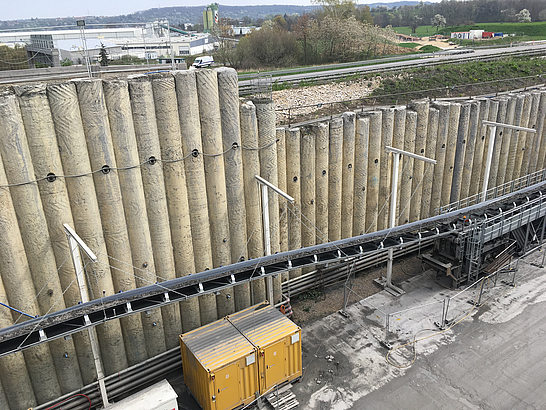
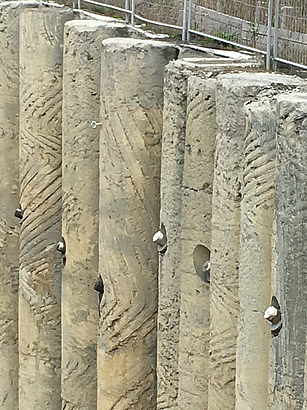
Bored pile walls are suitable for both temporary and permanent constructions. They can be combined with other types of retaining walls. For example, during the production of the individual piles of a bored pile wall, plug-in steel profiles can be used as soldier piles of a soldier pile wall produced on top of the bored pile wall.
Depending on static loads and permissible deformations, different types of retaining walls can be combined in different levels to overcome terrain jumps, as shown in the following figure.
Do you want to get started directly with the design of Bored pile walls? Just one "mouse click" will take you to the license variants of the software solution: GGU-RETAIN.
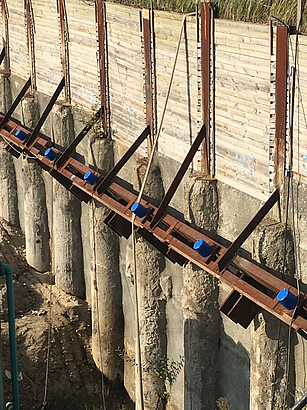
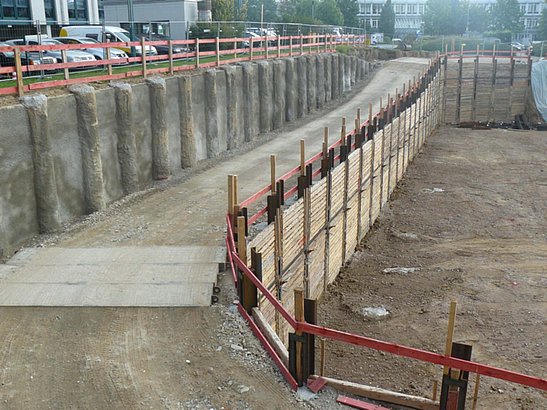
2. Construction
Bored pile walls consist of individually bored piles side by side. In the first step, a concrete drill template (guide wall) is produced at the ground surface. It control line and level of the retaining wall to be built. After that, boreholes are drilled using the rotary drilling method.
Bored pile walls are usually constructed by installing cased piles. The casing will be lifted when the concrete is poured. Due to low vibrations this can be done in the immediate vicinity of existing buildings. It is also possible to produce uncased boreholes. For this purpose, the borehole is supported by a thixotropic liquid, e.g. bentonite suspension. During concreting in the tremie process, the concrete displaces this supporting fluid from the toe to the top of the pile, which is collected at the surface of the terrain and pumped away.
After completion of the bored pile wall, the excavation of the excavation pit begins. Reinforced piles with large diameters allow deep excavations to be retained.
Depending on the actions at the surface of the terrain and the required excavation depth, bored pile walls can be constructed without anchors, with single anchors or with multiple anchors. Anchors can reduce the field moments and thus the required pile diameter. It also reduces the deflections and displacements resulting from the actions.
In most cases, grouted anchors are used for anchoring. In the case of highly loaded retaining walls, a waling on one or more levels can be arranged.
3. Wall types
Depending on their mutual arrangement and distance from each other, the following three main types of bored pile walls are distinguished:
The contigouis bored pile wall consists of reinforced piles that are in contact with each other or adjoining. It is not considered watertight.
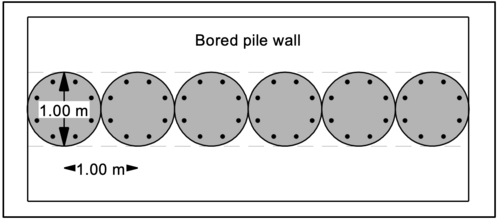
The secant pile wall is constructed in an alternating sequence of primary and secondary piles. In general primary piles are not reinforced. Secondary piles have to be bored within a few days delay in order to enable cutting into the concrete of the primary piles. Only the secondary piles as the load bearing piles are reinforced according to the static requirement. This type of retaining wall is considered to be almost impermeable to water due to the overlap of piles.
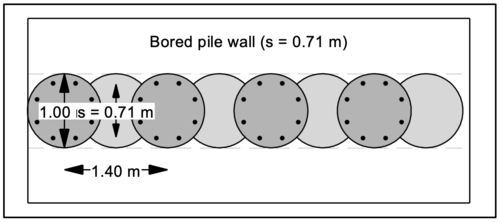
The soldier pile wall consist of the statically required number of reinforced piles. In particularly stable soils such as rock or grouted soils, the gaps between the soldier piles are not stabilized yet for a short time use only.
In general, the gaps between the piles are stabilized by a layer of shotcrete or even timber infill. In case of groundwater a drainage system has to be installed to prevent the shotcret from being loaded with bending.
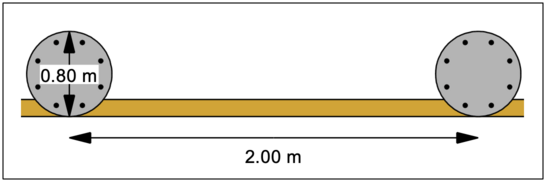
The following pictures show a contiguous bored pile wall used to secure a tunnel portal during the construction phase and a combination of a contiguous pile wall and a soldier pile wall, which were anchored in several levels due to the height of the terrain jump and the actions at the surface of the terrain.
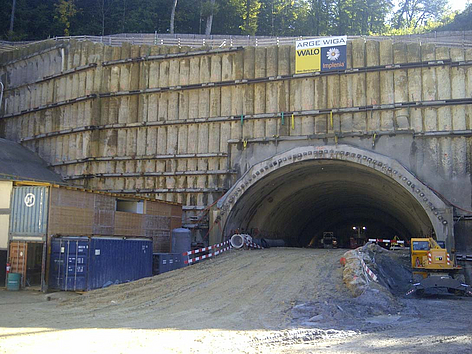
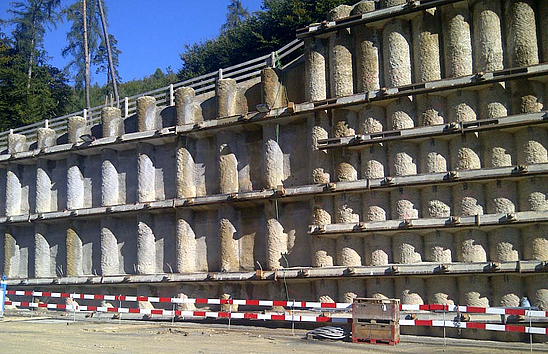
4. Static systems
Static systems are used to calculate internal forces and state variables, which depend on the selected embedment depth and anchors or struts in one or more planes:
- unsupported wall, fully fixed earth support
- single / multiple supported wall with free earth support
- single / multiple supported wall, fully fixed earth support
- single / multiple supported wall, partially fixed earth support
The calculation of bored pile walls can be carried out according to several procedures. The classical methods refer to the earth pressure theory and thus vary depending on the static system with regard to the magnitude and distribution of the earth pressure and the reaction forces in the soil. Basic systems are single or multiple supported beams that are freely supported or have a fixed earth support. A partially fixed earth support is also possible. More detailed information on the calculation methods, the approach to earth pressure, etc. is given in the EAB (Empfehlungen des Arbeitskreises “Baugruben”) and the EAU (Empfehlungen des Arbeitsausschusses “Ufereinfassungen”), among others. Computer aided methods also allow for the consideration of a bedding of the beam.
For a fully fixed earth support a rotation of the wall around a low-lying pivot point is necessary. The position of the pivot point is slightly above the base of the wall. Underneath, deformations occur that are directed towards the earth side and mobilize a reverse passive earth pressure there. For a simplified calculation, the BLUM equivalent force C is applied to the theoretical pivot point, which replaces the passive earth pressure below the pivot point and additionally corrects the simplified assumed passive earth pressure on the excavation side. Together with the resultant of the passive earth pressure this equivalent force C forms a pair of forces that represents the fixing of the bored pile footing.
Do you want to get started directly with the design of Bored pile walls? Just one "mouse click" will take you to the license variants of the software solution: GGU-RETAIN.
5. Necessary computational verifications
For retaining walls made of bored piles, the following individual verifications are necessary for the limit states mentioned, which can be carried out with the computer program GGU-RETAIN:
- Internal failure or excessive deformation of the structure or structural elements, including the bored pile itself, anchorage, struts, wailing etc., in which the strength of the structural materials is significant in providing resistance (STR).
- Failure or excessive deformation of the ground, in which the strength of soil or rock is significant in providing resistance (GEO-2), as for example:
- Analysis of the earth support, rotational failure of embedded walls (embedment depth)
- Analysis of the mobilized passive earth pressure
- Analysis of the vertical capacity
- Analysis of the deep seated stability
- Analysis of the heave of anchor soil (deadman anchors)
- Analysis of the pull-out-resistance of anchors
- Hydraulic Heave, caused by hydraulic gradients (HYD)
- Wall deformations and displacements (SLS)
- The safety of the overall stability must be investigated in all cases (GEO-3). The wall rotates about a pivot point and the whole system, including the wall, the anchorage and the soil fails as a rigid body. The necessary verification can be carried out e.g. with the computer program GGU-STABILITY.
Notes on use
All texts, images and media listed here are subject to copyright and are the intellectual property of Civilserve GmbH. Use is only permitted with appropriate reference and a link to this source.